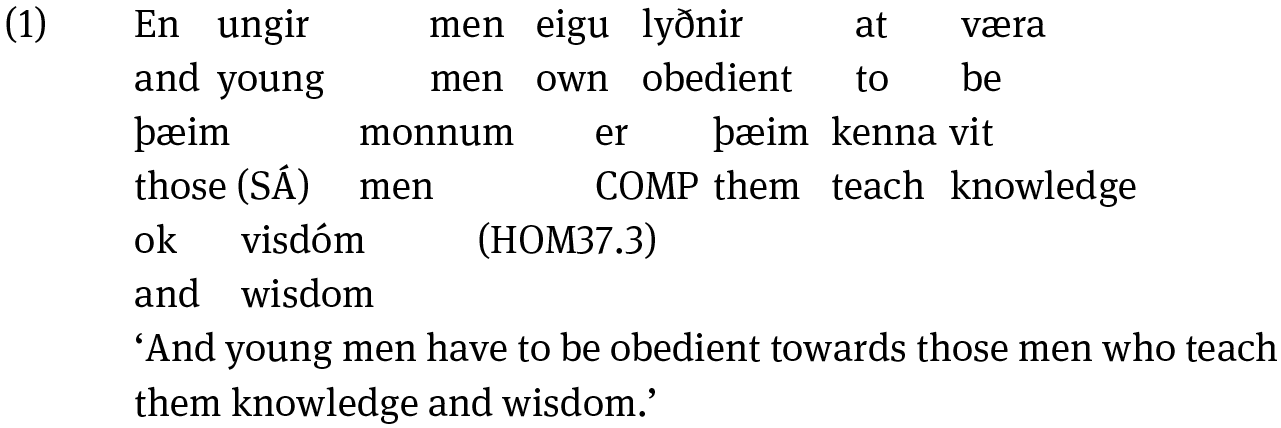4A short introduction to Old Norse relative clauses
The aim of this chapter is to provide a very sketchy introduction to the main properties of ON RCs. These properties apply also to Old Swedish (especially Early Old Swedish) and Older Middle Danish RCs, unless otherwise indicated.
ON RCs are all introduced by an uninflected complementizer (often called relative particle in the literature), either er or sem. Unlike Old Swedish, ON does not seem to accept RCs without complementizers: the few examples thereof are usually assumed to be mistakes (Heusler 1967:159). While the majority of er-clauses have a nominal antecedent (1) (Beutner 1987), er (or sem) is also near-obligatory in temporal (2) and locational (3) adverbial clauses, which sometimes renders delimitation difficult.



Traditionally (cf. Lindblad 1943, Heusler 1967:158), ON is not supposed to have had a relative pronoun. The few examples of the demonstrative sá and interrogative w-pronouns used as relative pronouns occur only in so-called ‘learned style’, often translated texts, and are usually regarded as being modelled on Latin constructions and not taken to reflect the spoken language.
It is very common for the noun antecedent to be modified by the demonstrative sá. Sá can be either prenominal (cf. 4) or postnominal (cf. 6).
ON RCs generally display so-called stylistic fronting: In RCs with subject gaps, a non-subject element (for example a direct object or an adverbial) usually occupies the pre-verbal position (highlighted in the example below).

NPREL in an ON RC can have practically any conceivable nominal function (Faarlund 2004:260), including dative complement of an adjective (5), instrumental dative or genitive complement of a noun. This means that ON allows relativisation of all functions on Keenan & Comrie’s Accessibility Hierarchy (1977)31, which makes it typologically rare (example taken from Faarlund 2004:260).

When NPREL is the complement of a preposition, ON RCs uniformly leave the preposition stranded and never avails itself of pied-piping.
As pointed out by Faarlund (2004:261, his example), ‘the relative clause may have a very loose connection to the matrix sentence’.

ON relative complexes are often left-dislocated:

As this example shows, the left-dislocated RC is recapitulated by a co-referential pronoun (usually a personal one) in the main clause. To set it apart from resumptive pronouns proper, which appear inside the RC, I will call this type of co-referential pronoun a recapitulating pronoun. While the type of resumptive pronoun exemplified by (8) is very common, one is far less likely to come across resumptive pronouns which occupy the position of NPREL inside the RC, like the first occurrence of hann in (9)32:
As regards the positions available for the ON RC, it is most commonly extraposed, but also appears frequently in centre-embedded positions (sentence-internally).

The RC might be extraposed together with the demonstrative sá (11), but might also be separated from it (12). The latter option is more common.


The most important difference between the Early Nordic languages is the presence in Early East-Nordic of 0-RCs, i.e. RCs without any relativizing element (pronoun or complementizer), cf. (13) from SJÆ. This construction is absent from ON. (This is my conclusion at least; as Chs. 14–17 will show, there is no consensus on this among scholars.)
There is also some intra-Nordic variation regarding the complementizer, although this mainly applies to the younger stages. All Nordic languages share er/ær as the main relative complementizer in the earliest texts, with sem/sum gradually winning ground from the 1100s on. (The latter development happens somewhat sooner in the East Nordic languages.) In MLD (and to some extent also OSW), the locational adverb thær is used as or develops into a relative complementizer; in MLD, it is dominant from around 1300. It is only sporadically found in MLN, and then in texts influenced by Danish.


